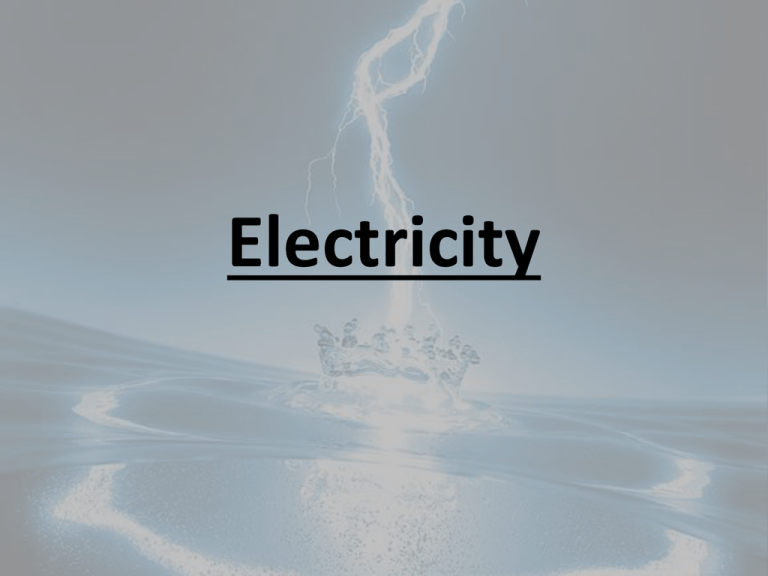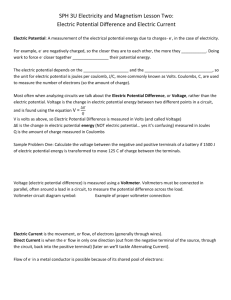Electricity
advertisement

Electricity • Electric Charge- property that causes subatomic particles such as protons and electrons to attract or repel each other • An excess or shortage of electrons produces a net electric charge • Like charges __________, and opposite charges __________ • Electric Force- force of attraction or repulsion between electrically charged objects. Charles-Augustin de Coulomb • French scientist (17361806) • Coulomb’s Law- the electric force between two objects is directly proportional to the net charge on each object and inversely proportional to the square of the distance between them. • Coulomb- SI unit of charge= 6.24 x 1018 electrons or protons • F=K(qAqB/r2) • Coulomb’s Constant (K)= 9.0 x 109 Nm2/C2 Coulomb’s Law Example Problem #1 • A negative charge of -2.0 x 10-4 C and a positive charge of 8.0 x 10-4 C are separated by 0.30 m. What is the force between the two charges? Coulomb’s Law Example Problem #2 • Sphere A, with a charge of 6.0 μC, is located near another charged sphere, B. Sphere B has a charge of -3.0 μC and is located 4.0 cm to the right of A – What is the force of sphere B on A? – A third sphere, C, with a 1.5 μC charge, is added to the configuration. If it is located 3.0 cm directly beneath A, what is the new net force (magnitude and direction) on sphere A? • Electric Field- the effect an electric charge has on other charges in the space around it • The strength of an electric field depends on the amount of charge that produces the field and on the distance from the charge • Static Electricity- An accumulation of electric charge on an insulated body • Electrostatics- the study of electric charges that can be collected and held in one place charge can be transferred by friction, contact and by induction. • Law of Conservation of Charge- whenever there is a charge transfer, the total charge is the same before and after the transfer occurs. The total charge in an isolated system is constant Charging Friction Definition: Examples: Contact Induction • Static Discharge- occurs when a pathway through which charge can move forms suddenly • Insulator- a material through which a charge will not move easily – Glass, dry wood, plastics, cloth, dry air • Conductor- a material that allows charges to move about easily – Metals, plasma, graphite Electroscope • Myth Buster's Van de Graaff Generator Electric Current • Electric current- continuous flow of electric charge • Ampere (A)-AKA amp- SI unit of electric current – 1 Amp= 1 Coulomb per second • The 2 types of current are direct current and alternating current – Direct current- charge flows only in one direction – Alternating current- flow of electrons that regularly reverses its direction. • Electrons flow from the negative terminal of on battery to the positive terminal of the other battery, but the current is in the opposite direction because it is defined as the direction in which positive charges would flow Resistance • Resistance- opposition to the flow of charges in a material • Ohm- SI unit for resistance • A material’s thickness, length, and temperature affects its resistance. • Superconductor- a material that has almost zero resistance when it is cooled to low temperatures Voltage • In order for charge to flow in a conducting wire, the wire must be connected in a complete loop that includes a source of electrical energy • Potential difference- AKA Voltage- the difference in electrical potential energy between two places in an electrical field. • Volts- SI unit for potential differenceJoules/Coulomb Voltage Sources • Battery- a device that converts chemical energy to electrical energy Ohm’s Law • Georg Ohm- (17891854) • Published research in 1826- so controversial that he was fired! • V=I x R • Voltage in a circuit equals the product of current and the resistance • I=V/R • Increasing the voltage __________ the current. Keeping the same voltage and increasing the resistance __________ the current. Electric Circuits • Electric Circuit- a complete path through which charge can flow • Circuit diagrams- use symbols to represent parts of a circuit, including a source of electrical energy and devices that are run by the electrical energy. – Open circuit: Switch open – Closed circuit: Switch closed • How is the direction of current defined? • Series circuit- charge has only one path through which it can flow. – If one element stops functioning in a series circuit, none of the elements can operate • Parallel circuit- electric circuit with two or more paths through which charges can flow – If one element stops functioning in a parallel circuit, the rest of the elements still can operate Electric Power and Energy Calculations • Electric power- the rate at which electrical energy is converted to another form of energy • Watt- Joule/second • P(watts)=I(amps) x V(volts) Power Example • A clothes dryer uses about 27 amps of current from a 240 volt line. How much power does it use? Electrical Energy • E= P x t • Kilowatt-hour- SI unit of electrical energy= 3,600,000 Electrical Safety • Correct wiring, fuses, circuit breakers, insulation, and grounded plugs help make electrical energy safe to use • Fuse- prevents current overload in a circuit • A wire in the center melts if too much current passes through it- “blowing a fuse” • Circuit breaker- switch that opens when current in a circuit is too high • Grounding- transfer of excess charge through a conductor to Earth • Ground Fault Circuit Interrupter (GFCI)monitors current flowing to and from an outlet or appliance






